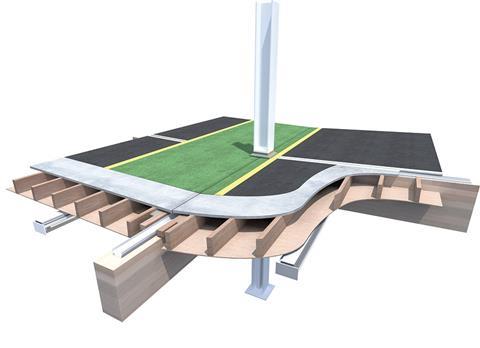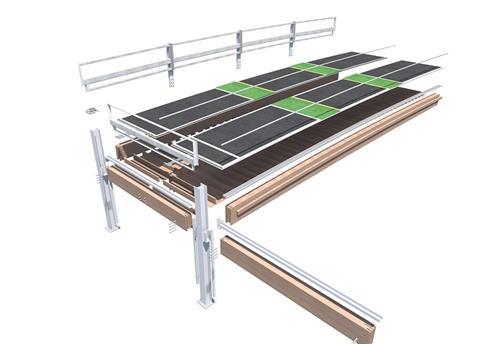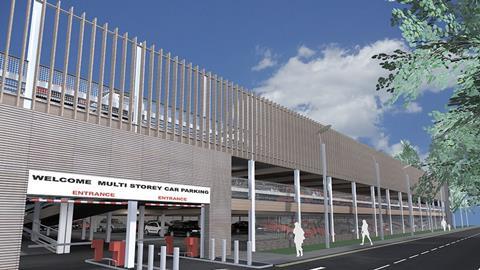A timber-frame, zero carbon car park. YouŌĆÖve got to be kidding?
Timber-frame buildings have made rapid progress in many construction sectors including the residential and commercial markets. But one application for which timber-frame construction has never appeared naturally suited is car parks. And much less multi-storey car parks. Until now.
Bourne Construction Engineering, through their subsidiary Bourne Parking; has recently unveiled a prototype of a radical new timber-frame car parking model in Poole, Dorset. EcoDex is the UKŌĆÖs first carbon zero car park and it is made almost entirely from sustainable timber glulam construction. Although the two-storey, 100-spaces prototype uses steel columns, the designers insist that these could easily be replaced by timber. Additionally, the system can accommodate a maximum of up to four storeys.
EcoDex provides all the benefits of glulam and timber mixed with the strength and speed of steel. ItŌĆÖs quicker to construct than traditional alternatives
Terry Wood, Bourne
The prototype employs lightweight, modular construction. Its primary supporting frame is arranged on a standard layout with structural columns set out in a 16.8m x 4m grid and primary support glulam beams spanning up to 16m. These primary beams support suspended timber floor decks which contain pre-fixed drainage elements, lighting and services and a pre-finished hard-wearing surface course already applied. These pre-fabricated decks are manufactured off-site and delivered as pre-assembled units before being fixed to the primary glulam structure.
Terry Wood, business development director at Bourne is keen to stress the schemeŌĆÖs considerable technical, commercial and environmental benefits. ŌĆ£EcoDex provides all the benefits of glulam and timber mixed with the strength and speed of steel. ItŌĆÖs quicker to construct than traditional alternatives with typical programme savings, depending on the nature of the individual project, in excess of 50%. Also, as the system is extremely light weight in comparison with say a standard concrete car park there are also large cost savings in the provision of the foundations with foundation costs typically reduce 25%-40%.ŌĆØ
Wood also points out that the use of ║├╔½Ž╚╔·TV Information Modelling (BIM) technology and a ŌĆ£highly specialised standard kit of parts capable of being expanded or reduced to meet specific site requirementsŌĆØ can also reduce lead-in time to site ŌĆ£by around 25%.ŌĆØ Neither does Wood consider the use of stamndardisation to be a constraint pointing out that ŌĆ£all varieties of car park layout are still possible using the EcoDex system, whether the floor plates are flat, split level or circulation modules.ŌĆØ
Wood even stresses the aesthetic benefits of the EcoDex system over traditional concrete car parks referring to the ŌĆ£soft and natural finish of the exposed downstand glulam beamsŌĆØ being preferable to the ŌĆ£uninterrupted flat soffits of a more archetypal concrete finish.ŌĆØ

What about fire hazards?
In the minds of many, fire protection and prevention is a perennial concern when it comes to timber buildings and it is one whose seriousness is potentially elevated when dealing with a car park and the multiple combustive risks therein. But this too is a challenge that Bourne claim to have rigorously addressed. ŌĆ£Timber is actually noted for its inherent ability to withstand the effect of fireŌĆØ explains Wood, due to its ŌĆ£having the unique property of forming a charcoal layer on its surface and then slowing down the rate of burning.ŌĆØ
In practice, this principle is exercised at EcoDex by the adoption of a ŌĆ£sacrificial timberŌĆØ approach. This involves checking the dimensions of the residual sections of timber members after charring are sufficiently large to support the loads and specified deflections within the specified period of fire resistance.
Wood explains that this approach has been used on all ŌĆ£exposed structural timber elements and compositesŌĆØ and that the requirements for fire resistance have been assessed in accordance with EC5-1-2 design requirements. By so doing, Wood insists that under fire conditions, the mechanical resistance of all structural assemblies and members is assured and that the ŌĆ£sacrificialŌĆØ approach enables the timber to ŌĆ£retain its strength and shape for a considerable period during a fire.ŌĆØ

Environmental benefits
It is not just Bourne which is keen to point out the environmental benefits of their EcoDex system. Sustainability assessors Sustain have also been engaged to provide independent analysis and its report was overwhelmingly positive. Not only did it concur with BourneŌĆÖs findings regarding the speed of construction and the advantages of its lightweight, modular construction but it also went on to claim that not only did the prototype reduce carbon by 6,000kgCO2 per car parking space but that it is actually ŌĆ£carbon beneficial for the first 30 years of its lifetimeŌĆØ. This projection has been determined by the need to renew the decking surface after 30 years. However, Sustain principal associate Dr Craig Jones predicts that by that point, technology may have advanced sufficiently to provide a surface that does not require renewal thereby rendering EcoDex carbon beneficial indefinitely.
Sustain also estimated that EcoDexŌĆÖs embodied carbon levels were 55% lower than that of a traditional car park. This performance is generated by the use of sustainably sourced timber rather than traditional timber composites. This sustainably sourced timber enables carbon to be ŌĆ£sequesteredŌĆØ from the atmosphere in wooden beams or decking for instance found throughout the structure. As SustainŌĆÖs Dr Jones explains these carbon storage capabilities are critical to EcoDexŌĆÖs zero carbon credentials. ŌĆ£Carbon storage benefits can only be claimed with the use of sustainably sourced timber. However, without the benefit of carbon storage the timber car park is still 55% lower embodied carbon than a traditional alternative.ŌĆØ
So why did Bourne spend time, money and effort developing EcoDex in the first place when the traditional car park model appears so established? As Wood explains ŌĆ£the drivers for the system were both commercial and environmental. We identified that there was a need, drive and desire by the retail, commercial, rail and general construction sectors to reduce their carbon footprint. This provided a clear opportunity to manufacture and erect the worldŌĆÖs first zero carbon multi-storey car park and we are confident that there remains a good commercial market for it.ŌĆØ
BourneŌĆÖs confidence is certainly matched by the level of innovation in the EcoDex prototype. Whether it catches on commercially remains to be seen. But what is clear already is growing sustainability awareness across the industry has added yet another building type to the ever expanding market for timber-frame.construction.




























2 Readers' comments